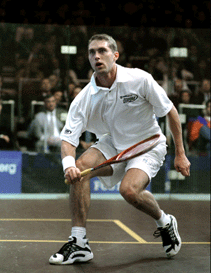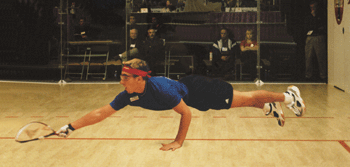|
|

Fast and Furious or Form and Finesse
What does the "personality" of your racket sport mean to your game?
By Steve Crandall
Vice President, Sales & Marketing
Ashaway Racket Strings
 Everybody knows that people have different personalities. But did you ever stop to think that sports do too? The personality of that sport affects your individual style of play, and even how you string your racket. Take racquetball and squash, for example. I play both competitively (in A League and C League, respectively), and here is what I've found:
Everybody knows that people have different personalities. But did you ever stop to think that sports do too? The personality of that sport affects your individual style of play, and even how you string your racket. Take racquetball and squash, for example. I play both competitively (in A League and C League, respectively), and here is what I've found:
Fast vs Form
Racquetball is a dynamic game. The ball is hard and bouncy, making the game fast. Players must make decisions quickly as the ball moves around the court at very high speeds. With drive serves typically clocked at 100 to 130 mph, a player must think and act fast in order to make the right decision about how to return it.
Squash, on the other hand, is methodical. The ball is soft and slow, so players do a lot of moving to the ball, rather than waiting for the ball to come to them. For this reason, form is essential, as it helps perfect the mechanics of a player's swing, and allows for better control.
Furious vs Finesse
In Racquetball, rallies are based on power, making the game furious at times. Racquetball's best shot is the "kill shot." Hit fast and low to the ground, it's an outright winner, or "rollout" at 6 inches or less above the floor! Players routinely dive to save shots from bouncing twice, and then bounce back up to recover and return to center court for the next shot.
Racquetball points last approximately 10 to 20 strokes, most hit with maximum power, with a few ceiling shots thrown in to allow a player to get back into a point. Racquetball players put their all into each shot, hoping that if it is furious enough, it will win them a point.
Squash requires that competitors play with finesse. Points are long, sometimes lasting 50 to 100 strokes. Outright winners, or "nicks," are few and far between, so a player needs finesse, and a style that allows him to consistently win points.
 Fitness
Fitness
If there is any ground shared by racquetball and squash players, it is fitness. Whether a player needs horsepower to dive for that next shot or stamina to stay on the court for hours, fitness can make the difference between winning and losing a match. But fitness is not only a requirement for racquetball and squash, it is often a big part of the reason we play. That's why, in my view, there is no loser in a hard fought game of racquetball or squash.
Stringing It All Together
Because of these distinctions between the racquetball and squash personalities, players usually make very different choices when it comes to stringing. Racquetball players may string their rackets looser for more power, while squash players might go tighter for increased control. Racquetball players hunt for thicker strings offering optimum durability, while thinner, textured strings are popular in squash. Gauge, tension, and materials are just a few factors to consider when making your choice.
If you are wondering how, specifically, the racquetball personality affects how you string your racket, look no further than the pros. Racquetball World Champion and #2 ranked IRT pro Jack Huczek uses a tough 16-gauge nylon polymer string from Ashaway, strung at a mid-range tension. Paired with his superb fitness level, this stringing style allows him to dominate the fast and furious worlds of amateur and professional racquetball. In comparison, Squash World Champion David Palmer replaces the Zyex(r) Ashaway strings in his racket before they break, to ensure consistent playability. Using an 18-gauge string strung tightly for better control, he relies on form, finesse and fitness to win.
Next time we will take a closer look at how the racquetball personality affects how you string your racket, and how you can use string to maximize the fast and furious elements of your game.
This article previously appeared in Racquetball Magazine.
|